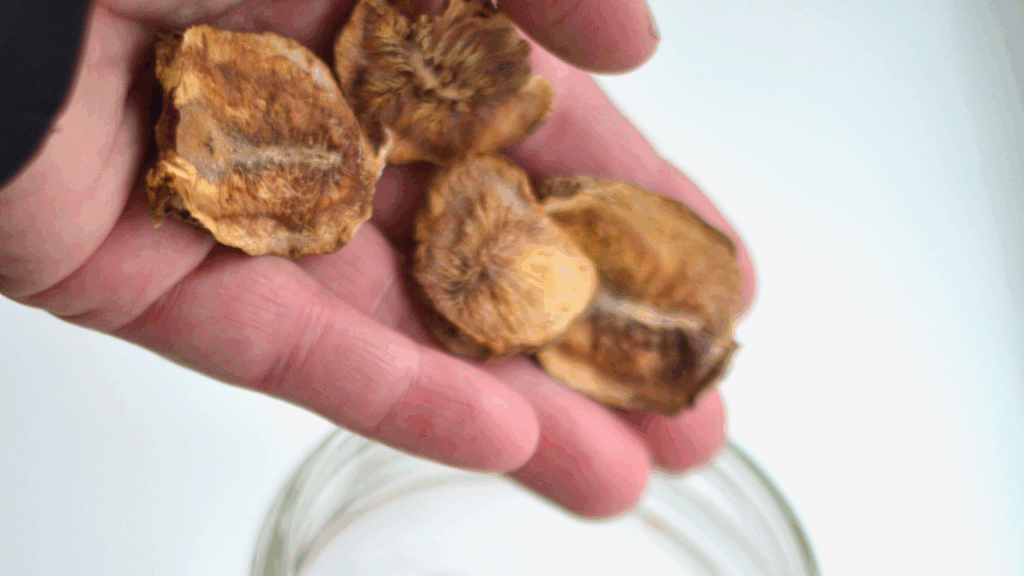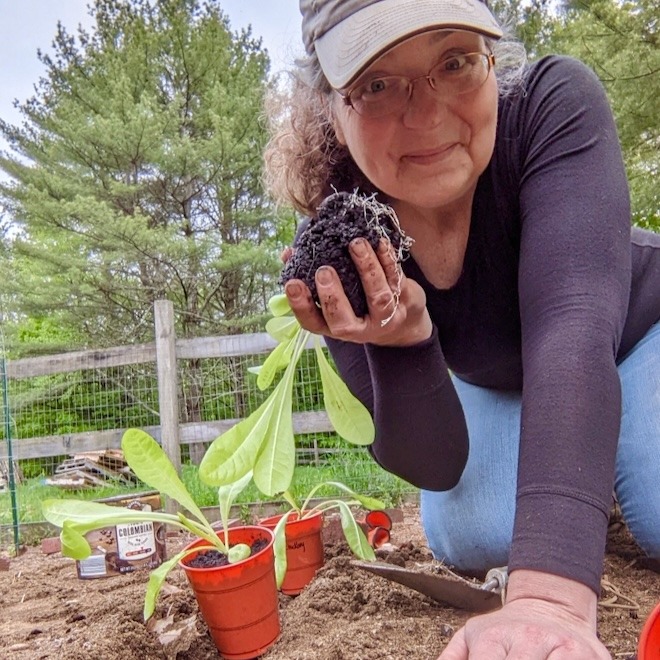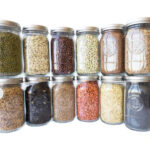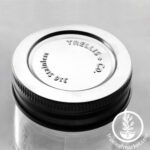Last Updated on October 23, 2025 by Michelle
When I discovered I could grow chicory for coffee, right in my backyard, right here in the US (on our New England farm) I knew I wanted to see if I could grow enough to last me all year, every year.
That was 5 years ago, and as of last year, I reached my goal. My “coffee” garden even made national news! Keep reading for all you need to know to grow chicory for a coffee substitute in the US.
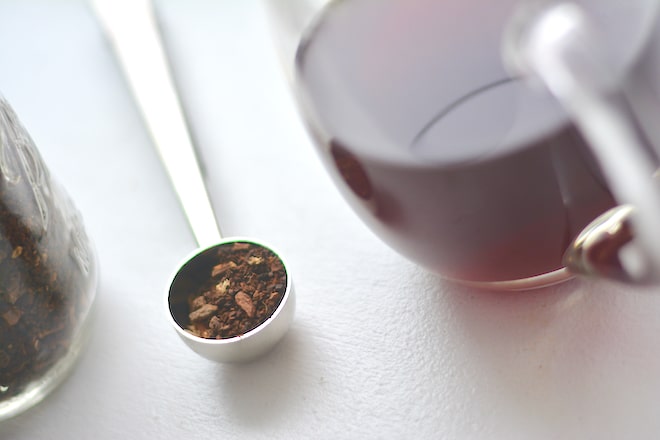
Chicory is an amazing, medicinal coffee substitute that I love just as much as coffee, even more in some ways. In fact, it’s not just me… it turns out many coffee companies cut chicory into their coffee (like this one) for improved taste and lower caffeine levels. Read more about adding chicory to coffee here.
Chicory is a coffee alternative made from the dried, roasted roots of the chicory plant. It has a deliciously woody, nutty, almost caramel-like flavor, with just a touch of natural sweetness. Why wouldn’t coffee companies use this goodness in their blends? And why wouldn’t YOU want to start growing it yourself?
So let’s dive in…
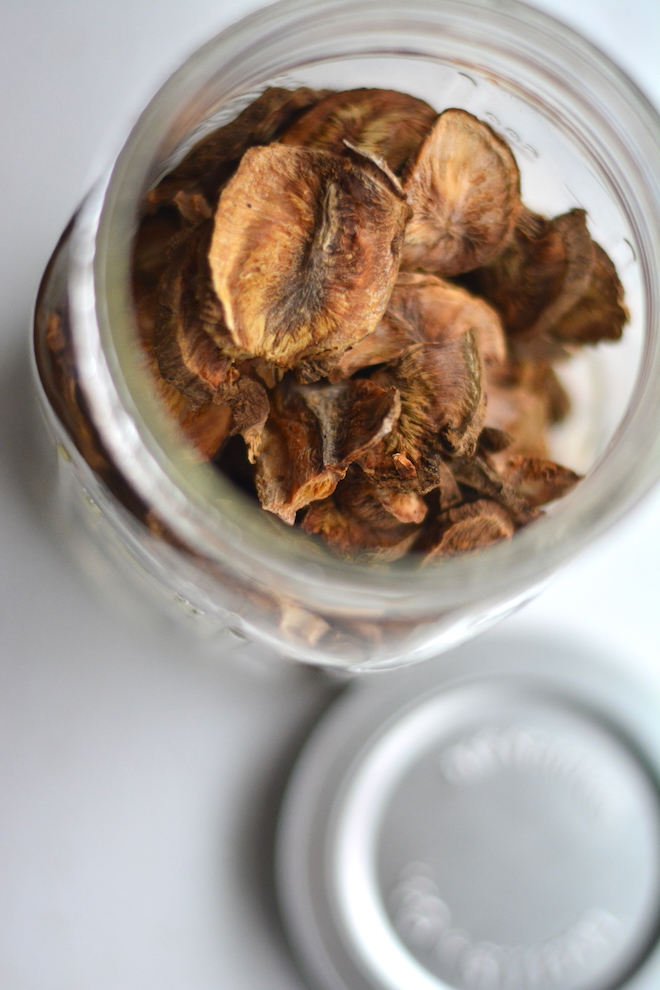
Growing Chicory for Coffee in the US
After learning how to grow the best coffee alternative–chicory–I knew I wanted to write this article to walk others through how easy this is. In fact, it was so simple and rewarding, I expanded my garden to include lots of medicinal ingredients, for making lots of awesome drinks. Read about my Medicinal Drink Garden here.
Read the national news article & watch the video of me harvesting my chicory in my New England garden right here.
What seeds do you use to grow chicory “coffee”?
The most important thing when growing this coffee substitute is to start with the right plants. I grow them from the seeds you can find right here.
I remember really struggling to find the right chicory variety because the pictures never matched what I was looking for. The pictures seem to never show the mature plant or the root that I harvest, but instead marketing pictures who a growth bud that can be forced in the winter indoors. These blanched buds, called chicons, are pretty complicated to grow and I’ve never tried that. So rest assured that these seeds are the ones you need for growing the best “coffee.”
Planting chicory for coffee
I plant my chicory seeds indoors in late February or early March, here in New England, and I transplant them to the garden a few weeks before the last frost, once the ground is defrosted enough to plant in it.
Indoors, I plant the seeds pretty shallow in the cups of dirt, about 1/4-inch-deep. Often multiple seeds wind up growing in each small cup (the seeds are tiny) and that’s totally fine. When it’s time to plant them in the garden, it’s easy enough to gently separate the plants.
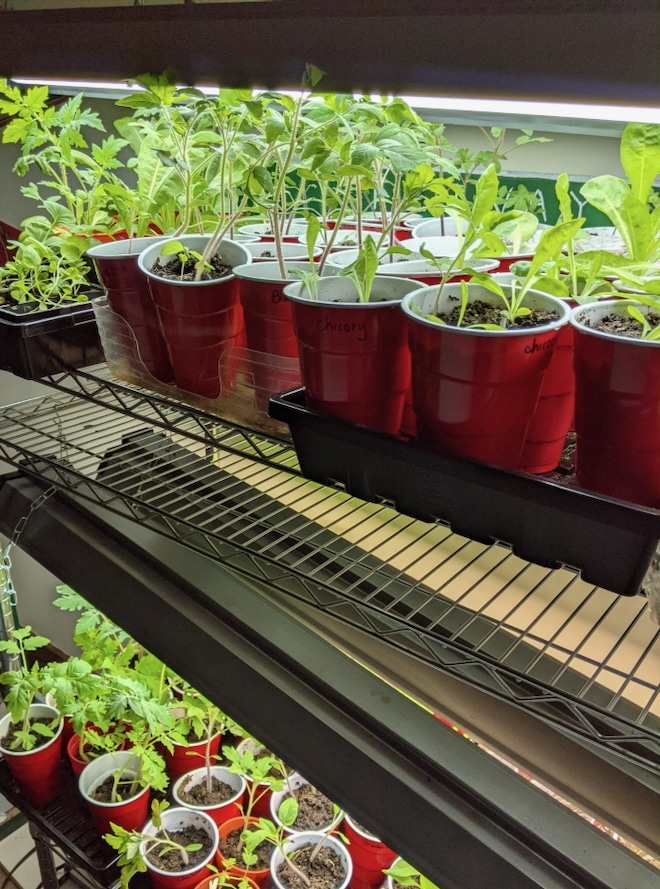
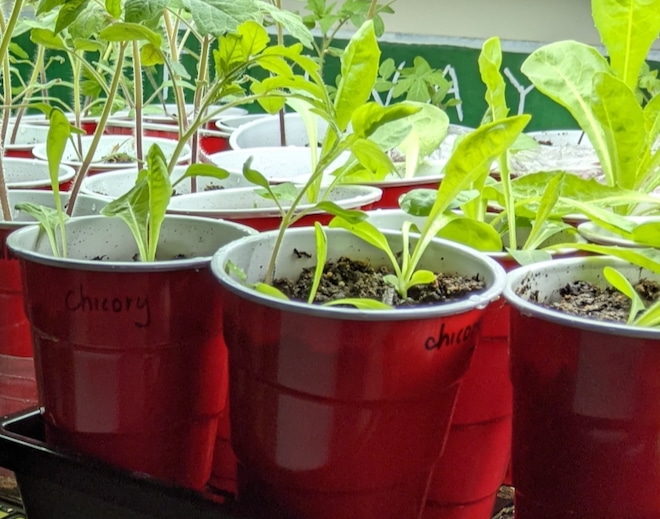
I place the small plants and about 1 foot apart, in rows set about 2 feet apart. But honestly I’m not sure you can mess this up… chicory are so hardy and I think they’ll prosper no matter how you choose to place them in your garden.
Chicory does best in full sun in a soil with a pH of 5.5 or greater. (If you want to know more about what I learned–the hard way–about soil pH and why occasional soil testing is important for your garden.)
Sidenote, you definitely can direct sow chicory seeds but I haven’t had good luck at that, no idea why, since it is such a hardy plant, but I’ve decided to stick with the “sure thing” of growing my seedlings indoors instead of taking a chance of not having much chicory one year. When my supplies have run low though, I do have a great source where I stock up on my roasted chicory.
Also, the plants do need a good amount of nitrogen in your soil if they’re going to thrive (and i’m lacking in that) so I like to plant green beans nearby or in subsequent years, since they are nitrogen fixing. I share a lot here about cover crops for a home garden.
Growing chicory
I let my chicory plants grow throughout the summer, but I do harvest leaves often (keep reading for more about that). I will harvest the roots after the first frost in the fall.
If you were growing chicory for the leaves (or to force the chicons I mentioned above), it’s a very different process, but I’m growing it for the roots. I partially harvest the leaves often throughout the summer as food for our pigs. I don’t cut the plant down to the ground but instead hand select many large leaves from each plant every time I harvest them.
And I routinely cut back any flower buds that start to form, because I want all the plant’s energy to go into growing big roots that I can roast for coffee.
Where does chicory grow best?
If you’re growing chicory for the greens, you’ll probably find it grows best in cooler temperatures (between 45 and 75 degrees), in cooler climates. But if you’re growing it for the roots, like I do, I find it’s very hardy in any weather my New England summers have dished out. And we’ve had some hot, dry summers lately, for sure. If you can keep your chicory bed weeded and watered decently, and if you occationally cut back leaves and keep the flowers from blooming, you’ll have very healthy roots.
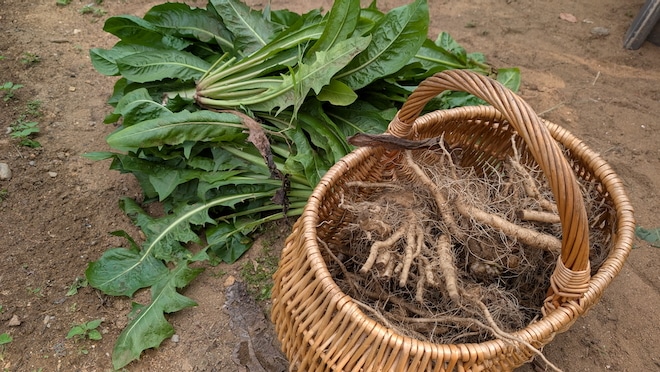
Harvesting chicory
I like to wait until after the first frost (or two) before I harvest my chicory roots, to get the sweetest and best quality roots. At the very least, make sure your plant has grown for at least 4 months, but closer to 6 is best. Digging after a rain will make it easier to extract the long taproot from the soil. . Okay, “like” is a strong word… Starting in about July I start longing to see the roots. I’ve often wondered if the roots would be generous size already, but I’ve never wanted to “sacrifice” a plant to find out.
Chicory roots
When you go to transplant your baby chicory plants you might be surprised to see all the fine, hair-like rootlets and wonder how they can look so very differently than the giant root you harvest 6 months later. It turns out those hair roots are extensions of the mature taproot, not a precursor to it.
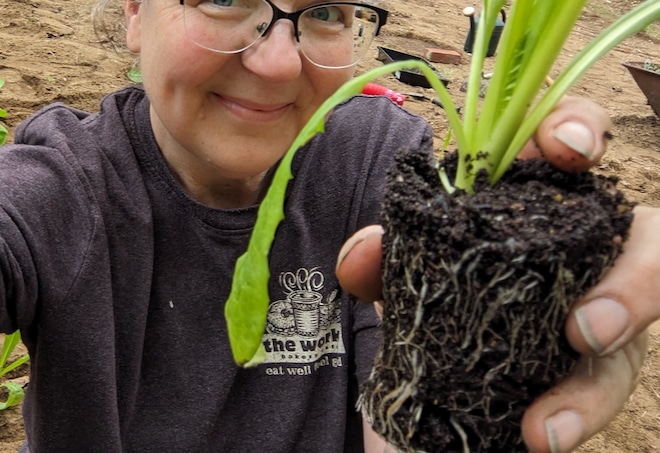

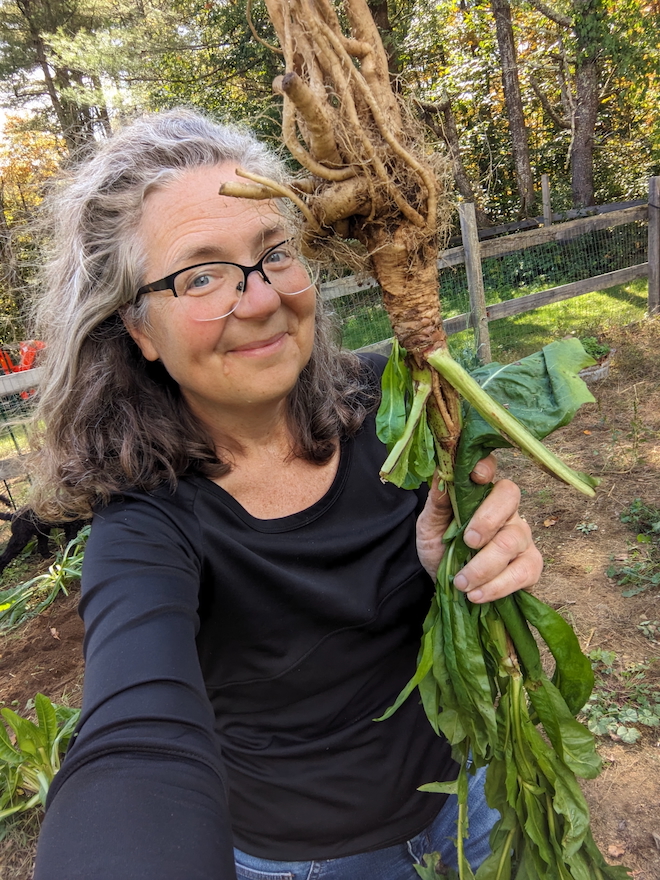
How to dry and roast chicory for coffee
To harvest your chicory roots, dig a wide circle nice and deep around each plant and go slowly to get all the roots that you can. Most of the time I unintentionally break off some chunks of roots, so I always carefully dig around in the ground to “recuse” any broken pieces. Once the root is out of the ground, I first separate the root from the plant, using my shovel. Then I shake the roots well to remove as much dirt as I can before washing them. As I wash them, I remove fine roots and I separate the smaller sections from the main part of the root, setting them aside.
Once all my roots are cleaned and separated into manageable chunks, I cut each piece into slices.
At this stage you need to dry them. You have a few choices:
- place them in the sun during the heat of the day (but protect from rodents etc) when possible, keep them open to the air and dry indoors when it’s not sunny outside. This will probably take many weeks.
- put your cleaned cut up roots in the dehydrator for 12 hrs at 95 degrees
- freeze dry your roots, after pre-freezing them for at least 24 hrs
Once they’re all dry they can be stored away until you’re ready to do the next step (or feel free to do it right away as well).
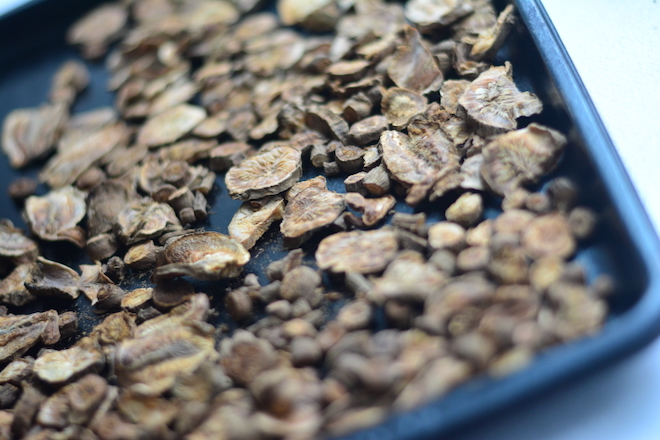
Roast your chicory slices for about 30 min to 1 hr, in 220 degree oven. (I’ve actually gone as high as 325 to shorten the time.) I spread the dried chicory roots out on a baking sheet in a single layer, and place them in the hot oven. This step is (kinda) optional, but it will give your chicory a deeper flavor. And you will, of course, have varying size slices, so I roast them on trays according to size so I can take the smaller pieces out sooner.
I’ve found the roots turn a pretty impressive shade of brown after 20 minutes in the oven. After that point, I set a timer for 10 minute intervals, and keep poking my head in the oven. The last batch of chicory roots that I roasted took about an hour. But I’ve had them take as little as 40 minutes, and as long as an hour and a half.
I pull them out of the oven at the point where they seem to be releasing the tiniest bit of smoke, although their color never seems to darken much past the color they achieve in the initial roasting period.
After roasting, your chicory is ready to grind. (As with the last step, you can store your roasted chicory in large slices and grind it later as well.) I like to brew a small test batch before turning off the oven. This ensures I’ve roasted them to the darkness I’m looking for.
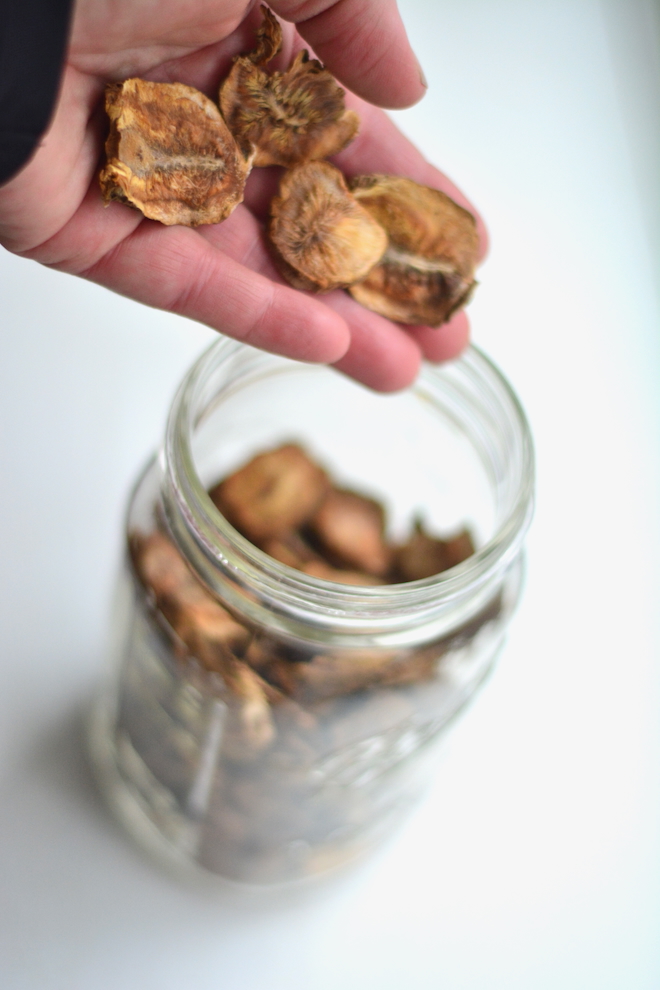
How to store & use roasted chicory
As I mentioned above, once they are roasted, chicory roots can be stored whole, or ground. I prefer to grind them on an as-needed basis, using either my mortar and pestle (which usually requires that I also run them through a sieve to get out the larger bits) or a regular coffee grinder. Roasted chicory coffee can be brewed in the same method you use for brewing bean coffee, but you’ll want to do some experimenting to determine how strong you like it. I find that I use about 1/2-1 tsp. of ground roasted chicory root per cup of brew.
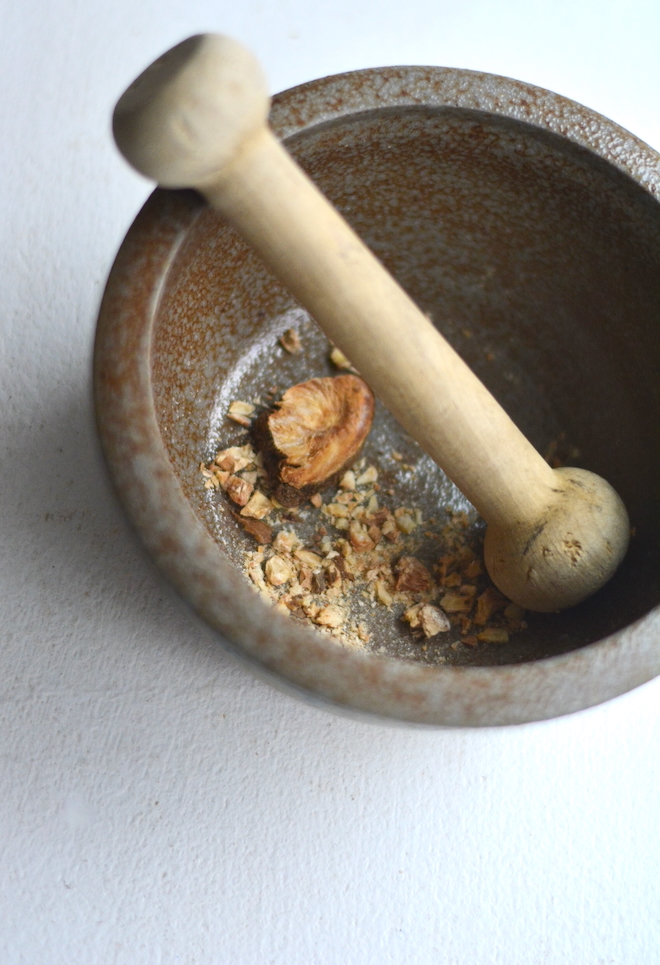
I like to enjoy my roasted chicory root “coffee” with a few delicious, medicinal additions. I will use my chicory in this herbal tea blend that tastes like coffee. I’ll often enjoy it with no sweeteners (the chicory is very slightly, naturally sweet) but I also love adding maple syrup for sweetness or I also make a batch of the tea blend with stevia leaves for added sweetness.
But you can definitely enjoy your roasted ground chicory by itself too. Keep reading for the recipe for the best cup of chicory.
How to make a cup of chicory coffee
Steep 1 TB chicory grounds in 16 ounces of hot water for 5-10 minutes.
Remove your steeper, and add whole milk and/or any sweetener you would like.
I often stir in 1 TB of maple syrup because it really brings out the chocolatey and caramel-ish undertones in the chicory’s taste profile.

Is chicory coffee?
Start here. It’s a ripple effect.
I love helping folks incorporate more real food into their lives, because it’s life changing. When we simplify our food, get rid of the processed junk… stop drinking the chemical-laden decaf coffee and find 1-ingredient roasted roots that taste even better, we take back control of our food and as a result we take back control of our health.
It’s a ripple effect. Start with one thing. The benefits can reach really far.
And be sure to grab all my resources to help you improve your pantry, one great ingredient at a time and save money while you’re doing it.
More articles like this one:
How to make your own tea blends
How to make Healthy Hot Chocolate mix
How to make a tea that tastes like coffee
Grab my complete pantry checklist right here and find out the best place to source all the best ingredients (bonus: it’s loaded with discount codes too)
A few things I use to roast chicory that tastes like coffee
Tell me about your chicory!
If you have any questions, leave a comment below. And please tag me on ig to show me your chicory tea! @souly.rested.
Pin this for later!


